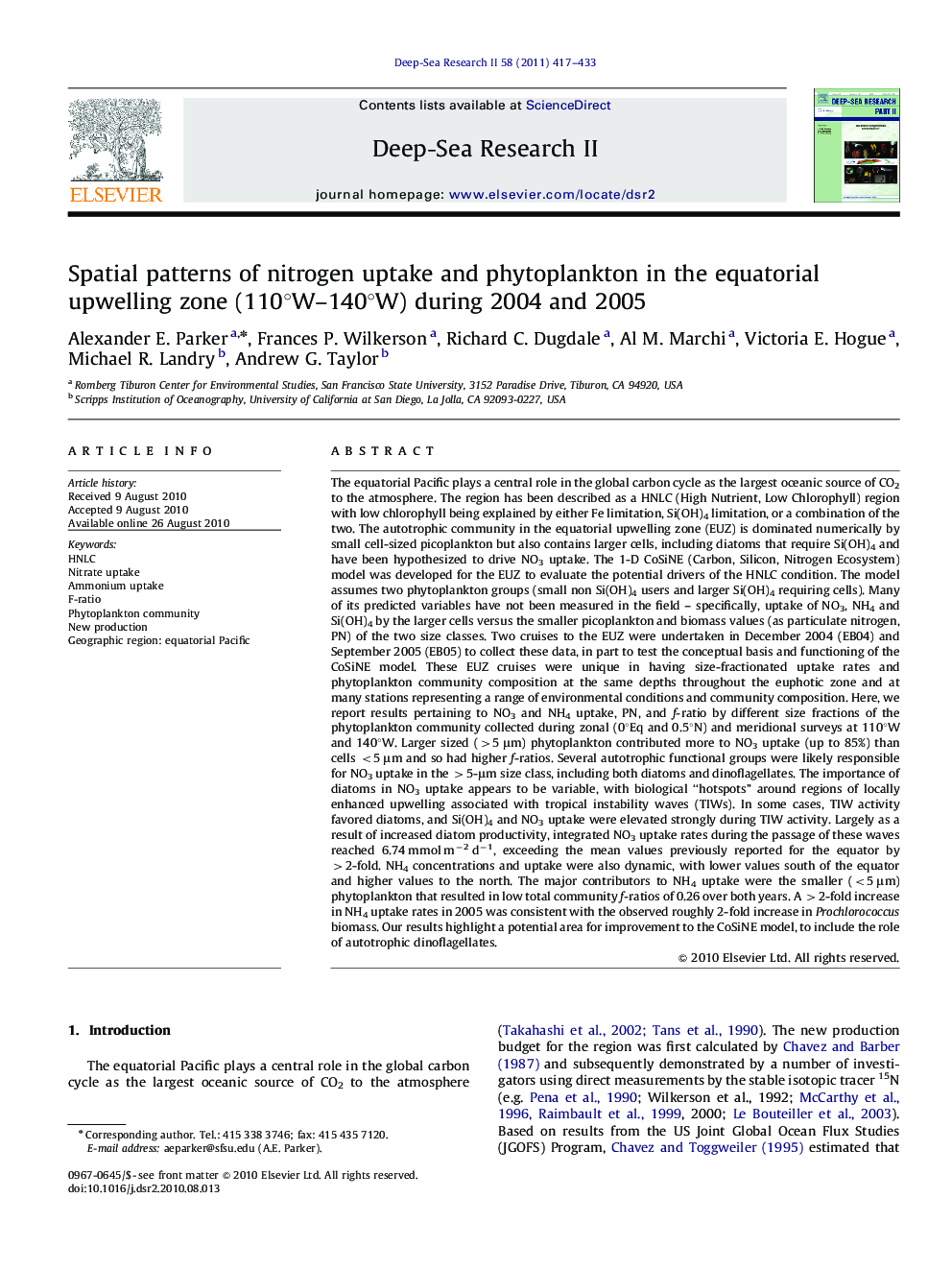| کد مقاله | کد نشریه | سال انتشار | مقاله انگلیسی | نسخه تمام متن |
|---|---|---|---|---|
| 4536977 | 1626468 | 2011 | 17 صفحه PDF | دانلود رایگان |

The equatorial Pacific plays a central role in the global carbon cycle as the largest oceanic source of CO2 to the atmosphere. The region has been described as a HNLC (High Nutrient, Low Chlorophyll) region with low chlorophyll being explained by either Fe limitation, Si(OH)4 limitation, or a combination of the two. The autotrophic community in the equatorial upwelling zone (EUZ) is dominated numerically by small cell-sized picoplankton but also contains larger cells, including diatoms that require Si(OH)4 and have been hypothesized to drive NO3 uptake. The 1-D CoSiNE (Carbon, Silicon, Nitrogen Ecosystem) model was developed for the EUZ to evaluate the potential drivers of the HNLC condition. The model assumes two phytoplankton groups (small non Si(OH)4 users and larger Si(OH)4 requiring cells). Many of its predicted variables have not been measured in the field -- specifically, uptake of NO3, NH4 and Si(OH)4 by the larger cells versus the smaller picoplankton and biomass values (as particulate nitrogen, PN) of the two size classes. Two cruises to the EUZ were undertaken in December 2004 (EB04) and September 2005 (EB05) to collect these data, in part to test the conceptual basis and functioning of the CoSiNE model. These EUZ cruises were unique in having size-fractionated uptake rates and phytoplankton community composition at the same depths throughout the euphotic zone and at many stations representing a range of environmental conditions and community composition. Here, we report results pertaining to NO3 and NH4 uptake, PN, and f-ratio by different size fractions of the phytoplankton community collected during zonal (0°Eq and 0.5°N) and meridional surveys at 110°W and 140°W. Larger sized (>5 μm) phytoplankton contributed more to NO3 uptake (up to 85%) than cells <5 μm and so had higher f-ratios. Several autotrophic functional groups were likely responsible for NO3 uptake in the >5-μm size class, including both diatoms and dinoflagellates. The importance of diatoms in NO3 uptake appears to be variable, with biological “hotspots” around regions of locally enhanced upwelling associated with tropical instability waves (TIWs). In some cases, TIW activity favored diatoms, and Si(OH)4 and NO3 uptake were elevated strongly during TIW activity. Largely as a result of increased diatom productivity, integrated NO3 uptake rates during the passage of these waves reached 6.74 mmol m−2 d−1, exceeding the mean values previously reported for the equator by >2-fold. NH4 concentrations and uptake were also dynamic, with lower values south of the equator and higher values to the north. The major contributors to NH4 uptake were the smaller (<5 μm) phytoplankton that resulted in low total community f-ratios of 0.26 over both years. A >2-fold increase in NH4 uptake rates in 2005 was consistent with the observed roughly 2-fold increase in Prochlorococcus biomass. Our results highlight a potential area for improvement to the CoSiNE model, to include the role of autotrophic dinoflagellates.
Journal: Deep Sea Research Part II: Topical Studies in Oceanography - Volume 58, Issues 3–4, February 2011, Pages 417–433